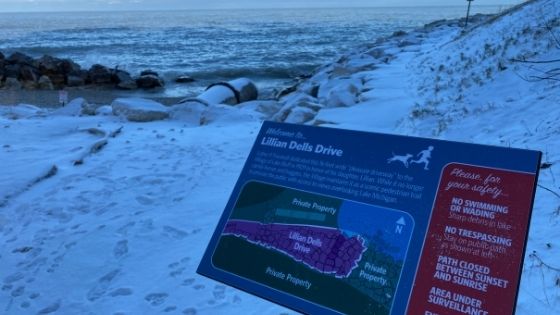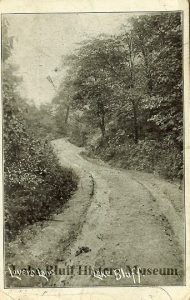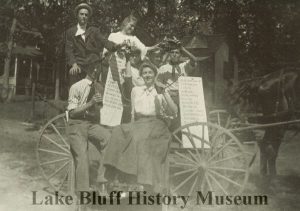The history of Lillian Dell’s Drive is as long and rocky as the meandering ravine-bed path itself. This narrow lakefront expanse that melting glaciers carved into the earth played a pivotal role in the lives of Native Americans, pioneers, summer guests and year-round villagers spanning at least three centuries, even winding up at one point on the Illinois Supreme Court’s docket. And quite aside from all that, the drive has been a surreptitious toboggan run for generations of Lake Bluff youngsters.
But who was Lillian Dell, and why does this narrow stretch of verdant ravine carry her name?
Before we talk about Lillian, let’s look at the drive. It’s a 16-foot-wide public path in a gently sloping ravine that starts at the tip of East North Avenue and ends at a private beach abutting Lake Michigan. The words public and private are in bold type to emphasize that you can freely walk down Lillian Dell’s Drive because it’s owned by the Village, which recently placed colorful signs there, but you can’t drive on it (unless on a horse-run buggy), and you most certainly can’t hang out at the lakefront. That belongs to nearby homeowners.
There’s hardly any beach there, anyway.
The lakefront at the foot of Lillian Dell’s Drive wasn’t always a pile of rocks and concrete debris. It used to be a white, sandy beach about 100-150 feet wide, with two sand dunes covered in native dune grass just north of the ravine.
(Let’s pause a moment to absorb that thought: Sand dunes in Lake Bluff!)
At the foot of the ravine was a deposit of flint, which Native Americans long ago used to make arrowheads, according to a recorded interview of Lawton Crosby, who lived in the Village from 1914 until his death in 2000. The land atop the bluff and for many miles west was a hardwood forest filled with white oak, black oak, red oak, hickory, ash, elm and maple. To guide them to the flint, Crosby said, Native Americans stationed trail trees every 300 or so feet from the glacial ridge later known as Green Bay Trail, at what’s now Bath & Tennis Club Road, east to the ravine.
This ravine was critical to the area’s first European settlers as well. In 1836 when the federal government opened Lake County to homesteaders, German emigrants John and Catherine Kloes (later changed to Cloes) travelled the lakefront north from Chicago, stopped at the ravine and walked up the bluff to check out the area. The Kloes laid claim to 100 acres, clearing 10 acres adjacent to the ravine for their homestead. While other settlers opted for the open prairie a few miles west, Kloes was “drawn by the wilder beauty of the lake shore and wide outlook from the bluff,” his youngest son wrote in a letter many years later.
Methodist businessman Solomon Thatcher also was charmed by the natural beauty of the forest, ravines and lake when he founded the Lake Bluff Camp Meeting Association (LBCMA) here in 1875. The LBCMA transformed the ravine from a rough hewn walking path into a drive for horse-drawn carriages to bring visitors to the beach. By night it served a different purpose, as summering couples meandered the secluded, moon-lit drive to view the glistening lake.
Thus the drive came to be known as “Lover’s Lane.”
But who, again, was Lillian? Lillian Dell Friestedt was a little girl whose family summered in Lake Bluff in the late 19th century. She was born with her twin brother George in 1885 to Luther Peter Friestedt and Dorothea Heuer Friestedt. Luther grew up in Wisconsin, first-generation Swedish, and became a Chicago alderman and civil engineer who had several mechanical patents related to the moving of buildings. Dorothea, known as Dora, was born in Germany and grew up in Milwaukee. Between 1884 and 1897 the couple had five sons and a daughter, Lillian.
Sadly, Lillian died in 1887, at just 2 1/2 years old, likely of a fever, according to Lynn Friestedt Steffen, a longtime Lake Bluff resident whose great-grandfather was Luther Peter Friestedt. (Lynn’s visit to the Museum helped put the pieces of this story together.)
In 1901, Luther Friestedt purchased lakefront land straddling the ravine from James B. Hobbs, a LBCMA director, with the goal of one day building a summer home for his family. The plat became known on official documents as “Friestedt’s addition to Lake Bluff,” but the dream home was never built. In 1909 Luther subdivided the land and donated the center of the ravine to Lake Bluff in memory of his daughter “as a public driveway to be kept in repair by the Village of Lake Bluff and to be used and maintained for a pleasure driveway only.” It was to be named Lillian Dells Drive after his little girl who had died some two dozen years earlier.
Were the Friestedts planning to keep a parcel for themselves? Did they change their minds about building in Lake Bluff? We don’t know. What we do know is that eventually they sold it all, including lots 1 and 2 in 1912 for $12,500 to John Bemer Crosby, a local legend in his day whose son Lawton was known as a “living treasure” in his day.
Not long after that sale, tragedy came again to the Friestedts. Dora died in 1913 at age 51, and Luther Peter died in 1917. He was 59.
The drama around Lillian Dell’s Drive started in 1916, when the Village and John Crosby became embroiled in a lawsuit after Crosby built a fence across the ravine path and posted signboards claiming ownership of the roadway. Crosby was taking matters into his own hands in an attempt to foil horse-drawn teamsters from traveling the ravine to haul away public sand and gravel for private profit, his son Lawton said in 1992.
Issues regarding Lillian Dell’s Drive ebbed and flowed for more than a century afterward, including a 1950 Illinois Supreme Court case where homeowners challenged the Village’s maintenance efforts and raised the question of whether a drive created for horse carriages in the 19th century should allow automobile traffic in the middle of the 20th century.
The court sided with the Village, and it said no to cars.
During the 70-plus years since then, various nearby homeowners have petitioned the Village to allow contractor trucks to haul rock and concrete down Lillian Dell’s Drive to shore up their eroding bluffs (those sand dunes of yore long gone). Up until the 1980s, the heavy concrete often came from old Lake County roads and highways and even in the 1960s from the demolished Villa Turicum estate in Lake Forest.
What would Dora and Luther have thought of the tug of war over their beloved daughter’s memorial drive? With their deaths in 1913 and 1917, the family’s connection to Lake Bluff was lost.
But not forever.
Now let’s fast-forward a generation. In the early 1950s Frederick Friestedt, who ran a successful construction management firm and was a grandson of Luther and Dora, moved from Chicago to Lake Forest with his wife, Blanche, to give their children a North Shore upbringing. Despite the family’s proximity to Lake Bluff, no one ever mentioned that an earlier generation of the Friestedts had summered there.
“It just never came up,” says Fred and Blanche’s daughter Lynn.
Until it did, one day in 1970. Blanche was a real estate broker, and her coworker sold a Lake Bluff house that closing documents referred to as being in the “Friestedt plat.” She asked Blanche if there was a connection to her husband. Blanche asked her husband’s family, and that’s when they learned of their long-ago ties to Lake Bluff and the drive named after Lillian Dell.
Lynn raised her children, Mark and Erik Steffen, in the Village, and she now lives in Green Oaks with her sister, Christine, while their brother, Bradford, recently moved to Lake Bluff. They are thrilled with the new signs at Lillian Dell’s Drive, today a scenic walking path named for a cherished girl whose connection to Lake Bluff was forgotten for decades.
And is now, thankfully, remembered.


